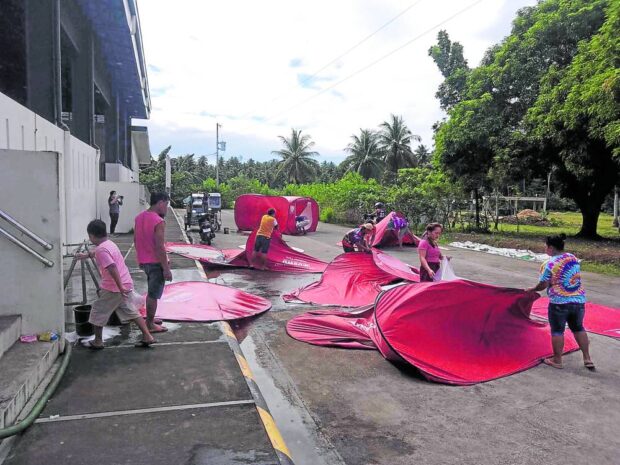
HOMECOMING Families at an evacuation center in Camalig, Albay, start cleaning and packing the modular tents that became their home for six months during Mayon’s unrest as they prepare to return to their villages. —CAMALIG MDRRMO
LEGAZPI CITY — After six months in evacuation centers, the remaining 55 families (211 people) in Camalig town in Albay were allowed to go home as the warning status of Mayon Volcano was lowered to alert level 2 (moderate level of volcanic unrest) on Friday.
Camalig Mayor Carlos Irwin Baldo Jr. said the evacuees from Barangay Anoling were asked to prepare for decampment last week after volcanic activities decreased based on the monitoring of the Philippine Institute of Volcanology and Seismology (Phivolcs).
“We will allow them to go home but we advised them to still avoid farming on the upper slopes of the volcano,” Baldo said in a phone interview.
In October, at least 2,441 families (8,763 people) were sent home in other Albay towns and cities but some families stayed at the Camalig Bungkaras Evacuation Center in Barangay Bongabong because their houses were near the 5-kilometer danger zone of the volcano and still vulnerable to lava and pyroclastic density currents (PDC or hot, fast-moving mixture of gas and volcanic debris).
The provincial government ordered the mandatory evacuation of residents inside the 6-km permanent danger zone on June 8 after the Phivolcs raised the alert status to level 3 (high level of volcanic unrest) at that time.
On Friday morning, the displaced families started to clean and dismantle the modular tents used at the evacuation center run by the local government.
“We’re happy that they will celebrate Christmas in their own village. Of course, the celebration is still meaningful at home,” said Edlyn Noble, head of the Municipal Social Welfare and Development Office of the town.
She said the local government would still distribute food packs and provide trucks to help families in the decampment.More than 100 children also underwent counseling on Thursday to help them adjust and ease their worries before they return home.
READ: Mayon calms down: Fewer earthquakes, alert level 2 declared
READ: The Mayon eruption of 1814
Still ‘abnormal’
Paul Karson Alanis, resident volcanologist at Phivolcs Legazpi, said their monitoring indicated a “general decline” in volcanic activities since the last week of November.
Based on the Phivolcs bulletin on Friday, the number of volcanic earthquakes on Mayon decreased from a monthly average of 11 daily in November to “nearly zero” in the first week of December.
Rockfall and PDCs also significantly decreased from monthly averages of 122 to 87 events per day and five to two events per day, respectively, between October and November to none in the first week of December.
Based on Phivolcs’ visual and camera monitoring, there has been a decreasing incandescence of the summit crater and fewer lava flow deposits since the last week of November.
Sulfur dioxide emission increased from 1,173 to 1,417 metric tons (MT) per day between October and November before falling to an average of 1,095 MT in the first week of December.
Warning
But Phivolcs said the lowering of the alert status was not an indication that the volcano’s unrest has ceased, considering that the edifice was still inflated and sulfur dioxide emissions remained high relative to baseline levels.
Alanis said the volcano was still considered to be in an abnormal condition, which meant that there was still the possibility of rockfall events, PDCs, and explosive eruptions.
“It will still emit materials every now and then because it is still unstable. The magma supply to the summit crater has significantly diminished, but rockfall events may still happen,” he said in a separate phone interview on Friday.
Alanis said residents should still avoid entering the permanent danger zone due to risks of sudden explosions, rockfalls, and landslides.
Heavy rainfall could also generate lahar and sediment-laden streamflows in channels where PDC deposits were lodged. —WITH A REPORT FROM GILLIAN VILLANUEVA